A complete guide to the wok, a versatile cookware that’s indispensable for Chinese cooking. It includes tips on purchasing, seasoning, usage and daily care.
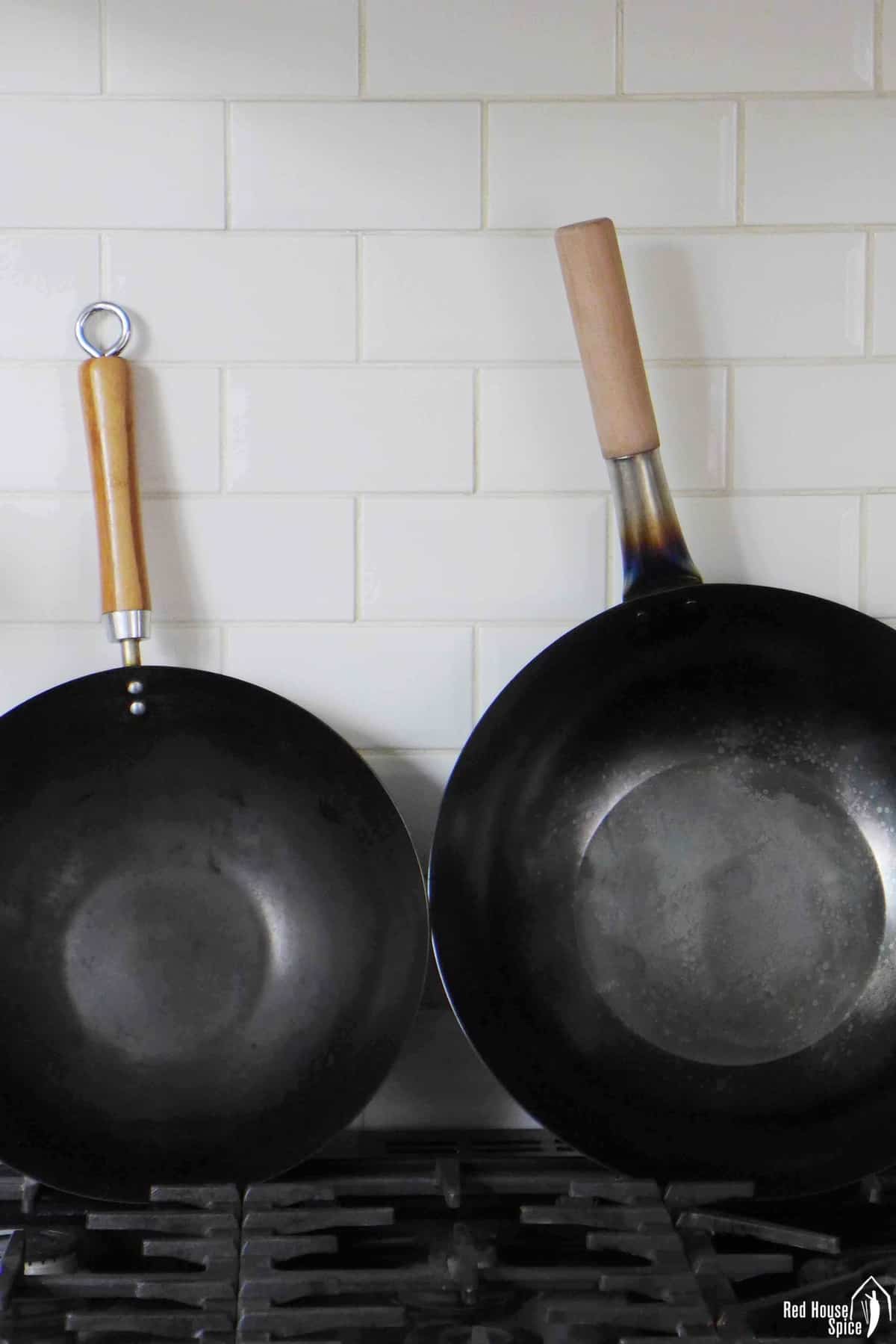
What is the most essential piece of equipment you’d find in a Chinese kitchen? Undoubtedly, it’s wok, a curved, high-sided metal cooking vessel that can execute all manner of culinary tasks. It’s an indispensable piece of cookware in Chinese households, and a family treasure for many as it can be passed on through the generations.
Although you could use other cookware (regular pots and pans), to cook many Chinese dishes, if you’re keen to dive deep into Chinese cuisine, then a wok is a must.
Perhaps you feel intimidated to start the journey cooking with a wok. Don’t be! In this complete guide, I’ll answer all the questions you may have and provide tips that you may find helpful.
N.B. This guide focuses on traditional carbon steel woks. It doesn’t apply to modern woks with non-stick coating.
Why is the wok special
Here are some of the key features of a wok:
The heat distribution is fast
Carbon steel woks react to heat very fast. They heat up and cool down quickly. This makes it possible to retain the tenderness of meat and the crunchy texture of vegetables.
It has different heat zones
Its bowl-like shape allows it to have different heat zones. So when stir-frying, you can move par-cooked ingredients to the side (lower heat) and cook new ingredients in the centre (higher heat) before combining them.
It holds ingredients well
Its steep side ensures that you can toss ingredients easily so that everything is cooked evenly. This also helps to catch the splatters of oil, sauces, etc. keeping your cooking area neat and tidy.
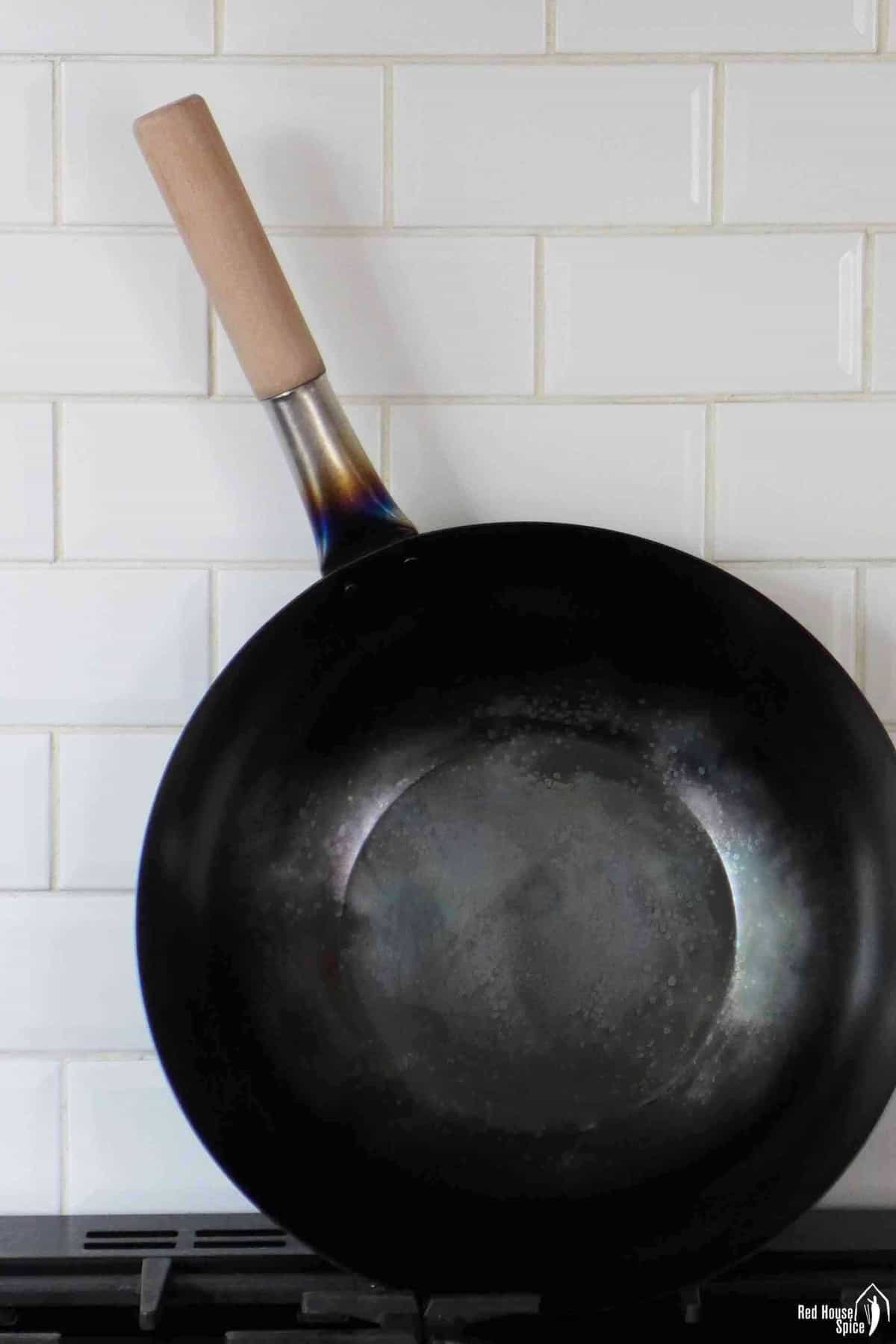
It can be used in multiple ways
I think many people associate the wok only with stir-frying, a cooking method commonly used in Chinese and many other Asian cuisines. However, the potential of a wok doesn’t stop here. It can be used to steam, braise, blanch, boil, deep-fry, and even smoke.
It lasts forever with simple care
Unlike modern non-stick cookware, a wok endures scratches very well and can be restored easily if left aside and become rusty. In fact, a wok gets better and better through usage.
Purchase
Like other cookware, woks come in different shapes, sizes and are made of various materials. You might be overwhelmed by the choices available and find it difficult to make a decision. For everyday home cooking, here are my recommendations:
Material
Carbon steel is the best option for a wok. Compared to cast iron, stainless steel, aluminium and copper, it has many advantages.
- It’s lightweight so you’ll find it easy to lift and make tossing movements single-handed.
- It reacts quickly to temperature changes. That means it can heat up and cool down in a short time. This is ideal for making quick stir-fries.
- It’s affordable, so you don’t need to spend a fortune on it.
- It’s durable. It’s hard enough to bear pressure yet it isn’t as brittle as cast iron. I’d say it’s almost impossible to destroy a carbon steel wok by home usage.
Shape
In terms of the shape of a wok, you have two choices: round bottomed or flat bottomed. Make the decision based on which type can sit stably on your burner.
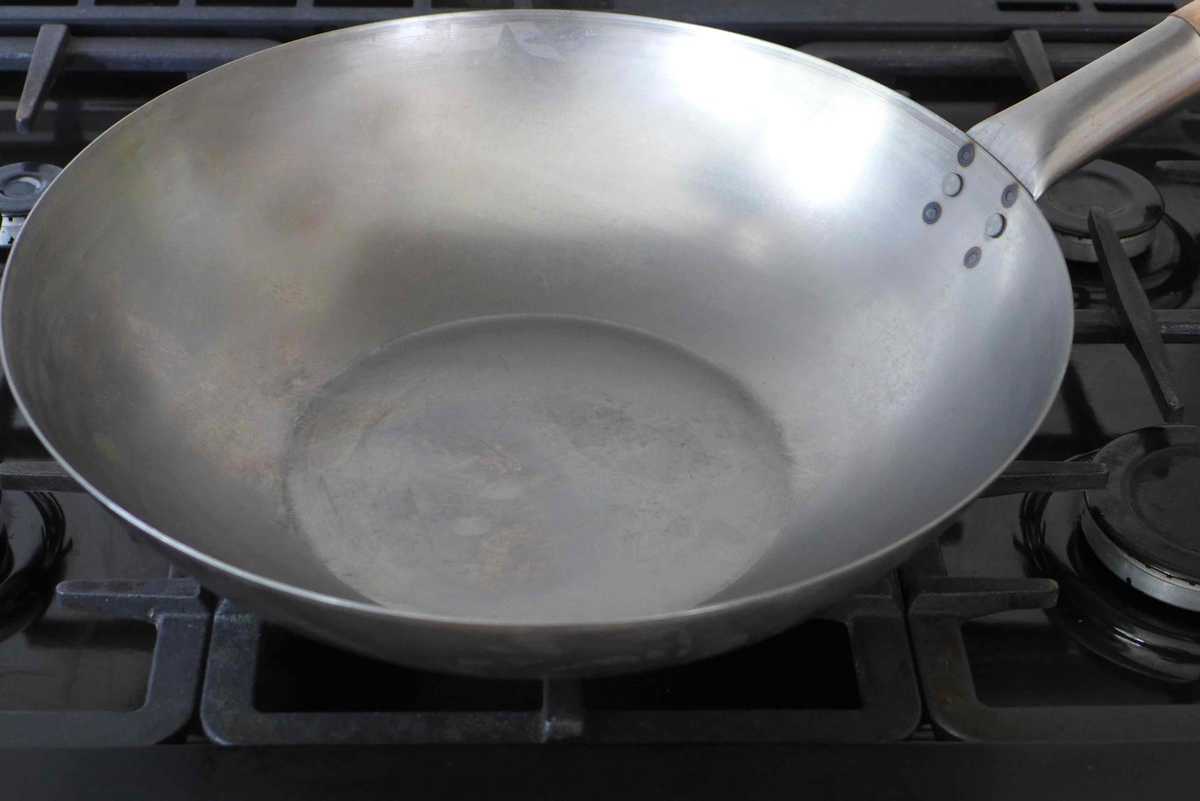
- The traditional Chinese wok has a round bottom which sits securely on the Chinese-style gas burner designed for this purpose. Choose this version if you have this type of cooker, or you have a wok support rack attached to your flat-top gas cooker.
- A flat bottomed wok (see image above)can sit stably on regular cookers, including electric and induction hobs. Its flat base also allows you to shallow fry food that you normally cook in a regular frying pan/skillet.
Size
I suggest you buy woks with a diameter ranging from 30cm/12″ to 36cm/14″ (measured across the rim). These are ideal sizes for everyday home cooking. If it’s smaller than those, you’ll find it difficult to fit in bulky vegetables (e.g. cabbage) and food spills easily while tossing.
Handle

Regarding the handles, if the wok is on the small side, one long handle would work (see image above). If it’s bigger, you may want to choose one with a long handle and an ear handle on the opposite side. This helps you to move it around easily when it’s filled with food. Woks with two ear handles require you to move them with both hands which might not be convenient.
I prefer wooden handles to metal handles as they don’t get hot during cooking. The benefit of a metal handle is that you can put the entire wok into an oven if you ever need to do so.
Lid
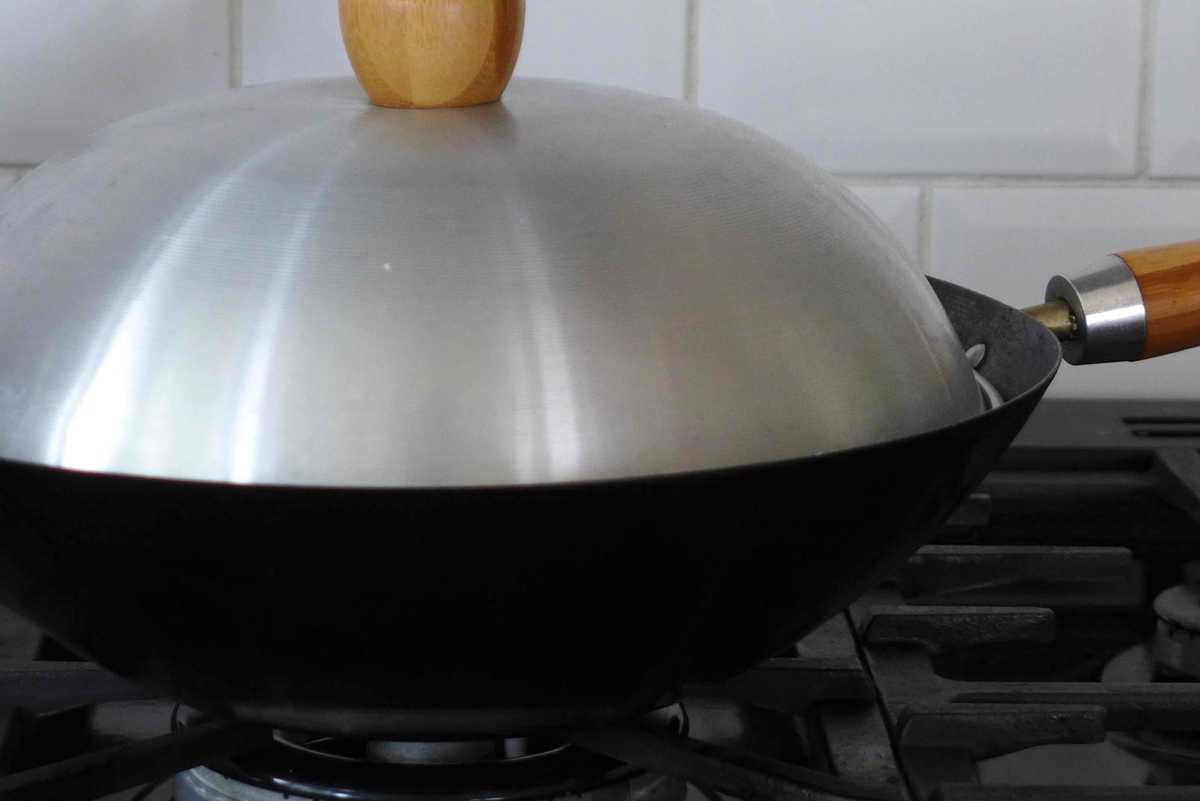
It’s not necessary to have a lid if you only use the wok to stir-fry. However, it’s required for steaming, braising, smoking, etc. Make sure it fits your wok well. If available, choose one that’s in a dome shape (see image above). This makes it possible to steam or smoke bulky food that’s higher than the wok’s rim, e.g. a whole chicken.
Season
What is the purpose of seasoning a carbon steel wok? Firstly, it’s to prevent it from rusting. Secondly, it’s to develop a natural non-stick surface through a process called fat polymerization. Simply put, by burning oil on its surface at a very high temperature, it gains a patina of hardened oil that has a non-stick effect.
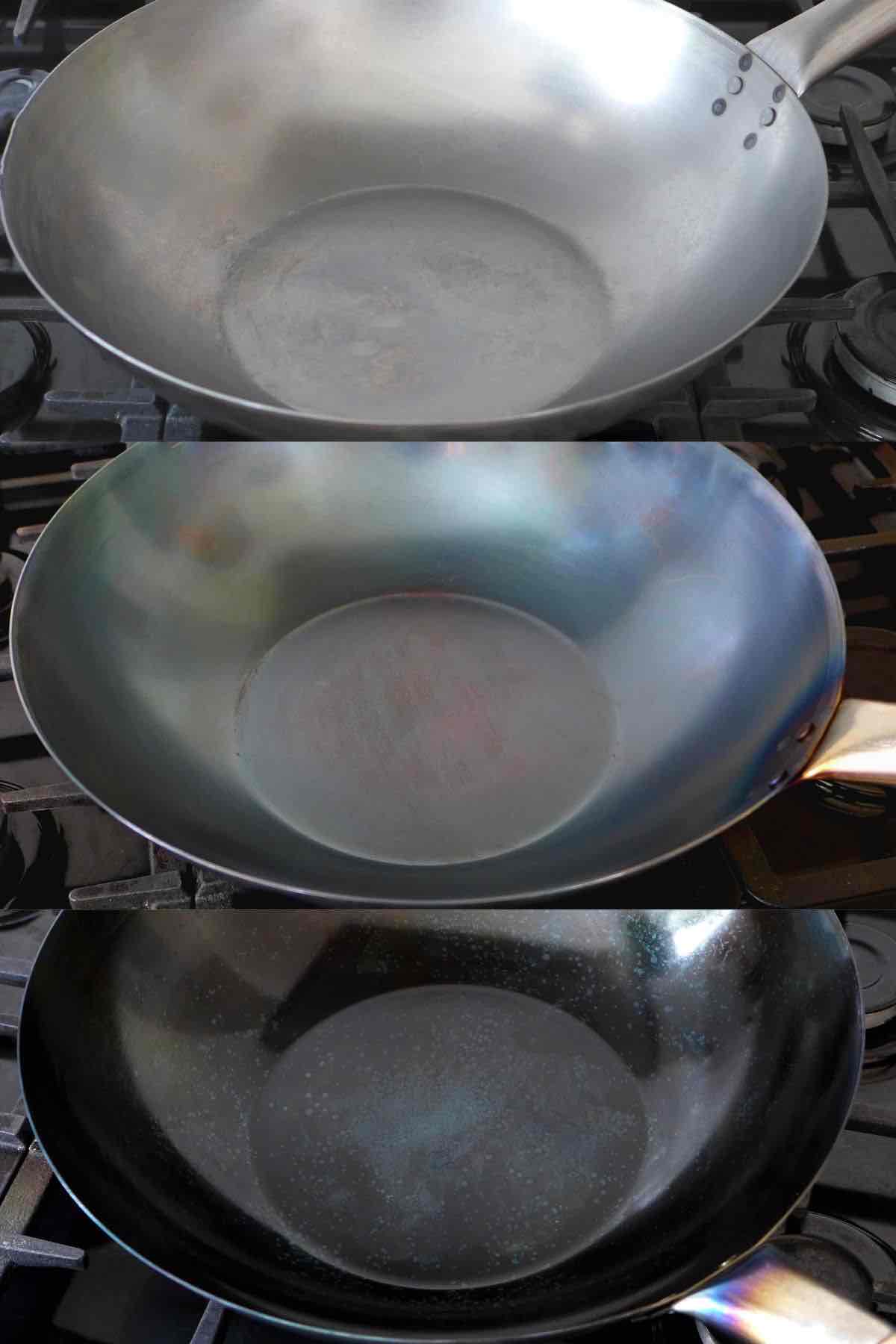
It takes three simple steps to season a new wok: remove the protective coating, burn it empty, and then burn twice again with a thin layer of oil. The photos above shows you how the colour of the wok changes during the seasoning process.
Before you start, make sure:
- Your kitchen is well-ventilated. Turn on the exhaust hood or open the windows/doors in case the smoke caused by burning oil sets off your smoke alarm.
- Use high heating cooking oil, such as canola, sunflower, rapeseed, corn, peanut, soybean, vegetable oil, etc. Olive oil, sesame oil, or other low smoking point oils, aren’t suitable for this purpose.
STEP 1: Remove the protective layer
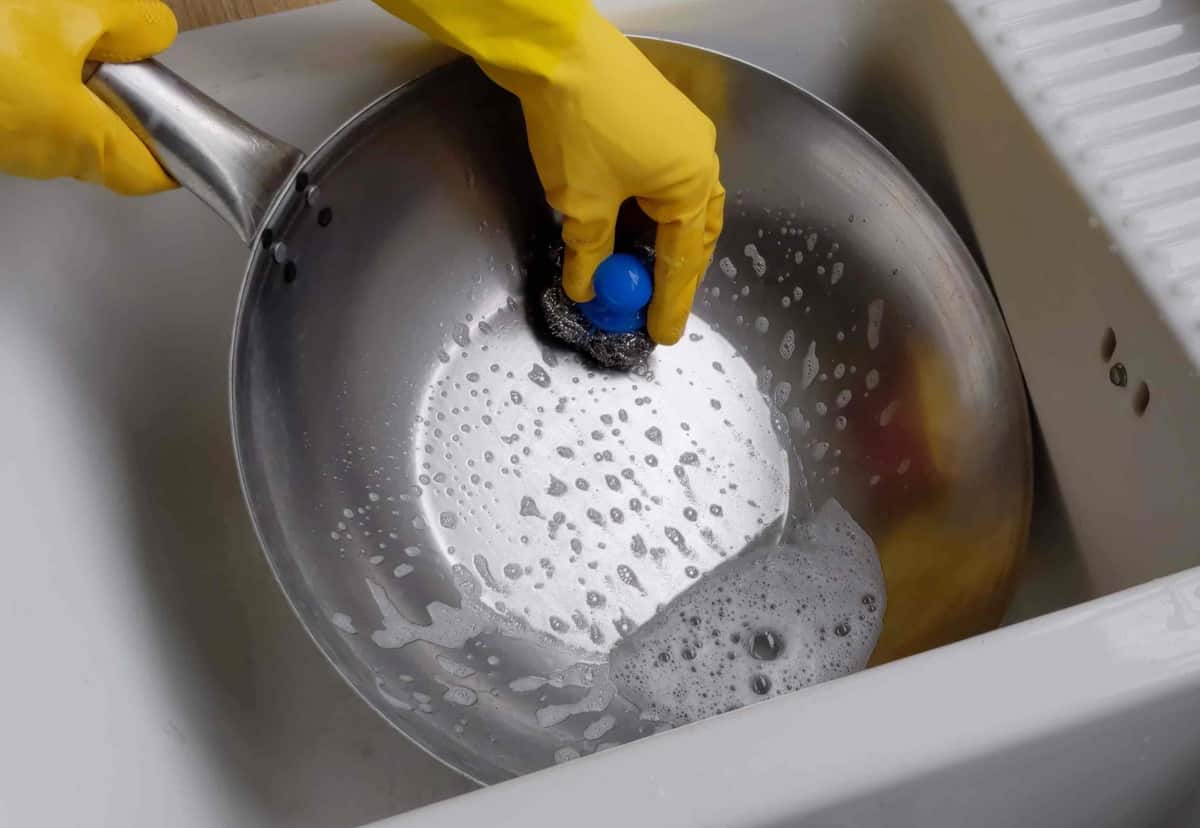
To prevent the wok from rusting while sitting in shops, factories always put an anti-corrosion protective coating over it. It can be either a layer of oil or a layer of transparent lacquer. You’ll need to remove it completely.
Wet a stainless steel scourer in warm water mixed with a little detergent. Then vigorously rub the surface of the wok inside and out. Make sure you don’t miss any area. Rinse thoroughly then wipe dry with a kitchen towel.
STEP 2: Burn the wok empty
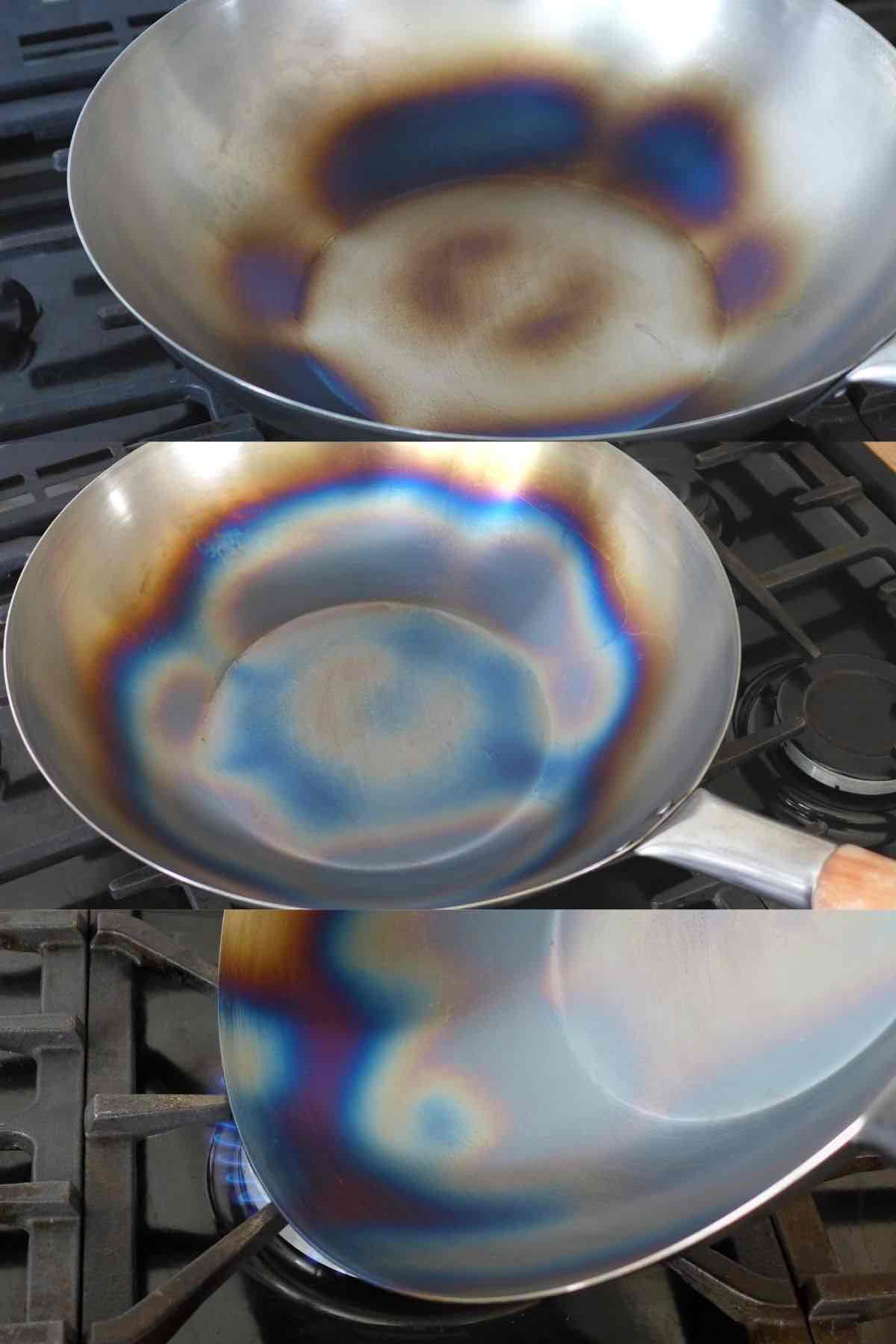
Set your cooker on high heat. Place the wok on top. Burn it thoroughly. You’ll notice the colour changing during this process, from silver-grey to golden, brown, a metallic rainbow shine, then finally settle down to a bluey grey colour (see image below).
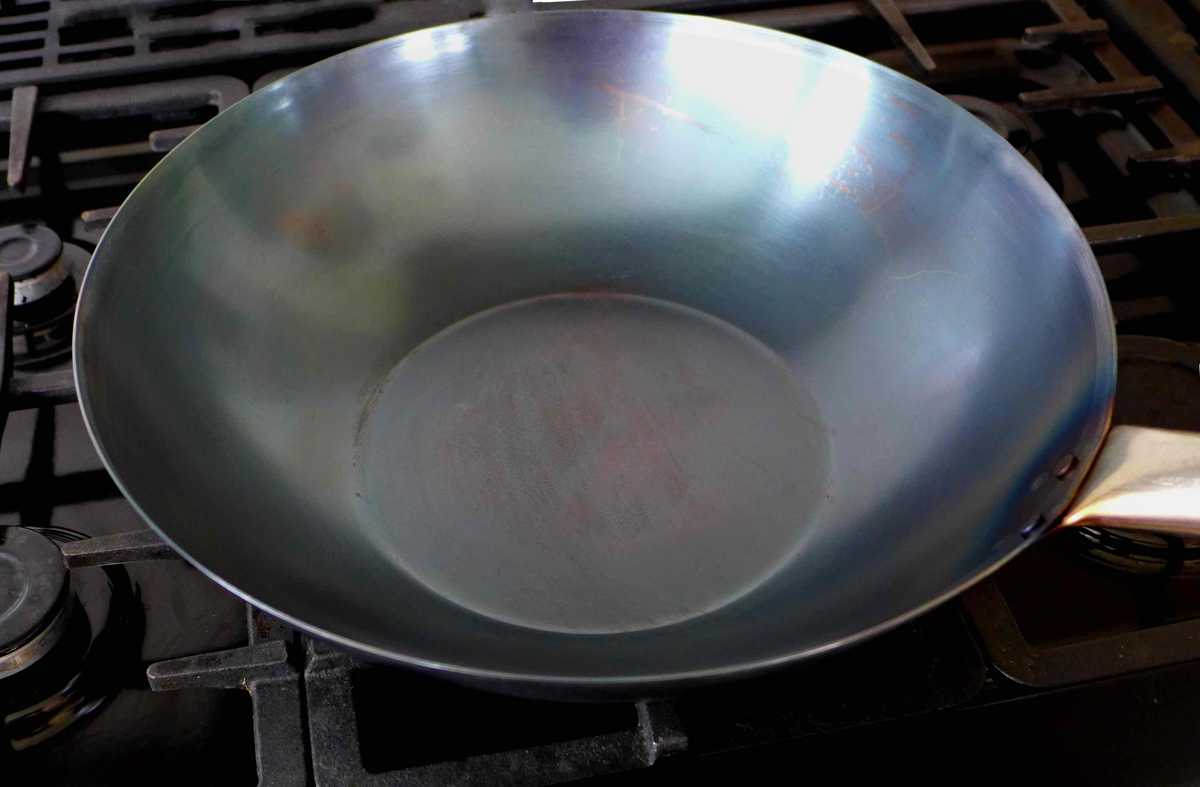
To make sure the wok is entirely burnt, hold the handle and move it in different directions so that each part has a chance to be in direct contact with the heat. Once all is done, let it sit for 5 minutes or so until it’s cool enough to handle.
STEP 3: Burn with a little oil

Pour a little oil into the wok. Use a piece of kitchen paper to rub the oil around the inner surface leaving just a very thin layer.
Burn it again over high heat. Focus on one area at a time. You’ll see smoke rise from the heated part and the colour darkens. When there is no more smoke appearing, move on to another area.
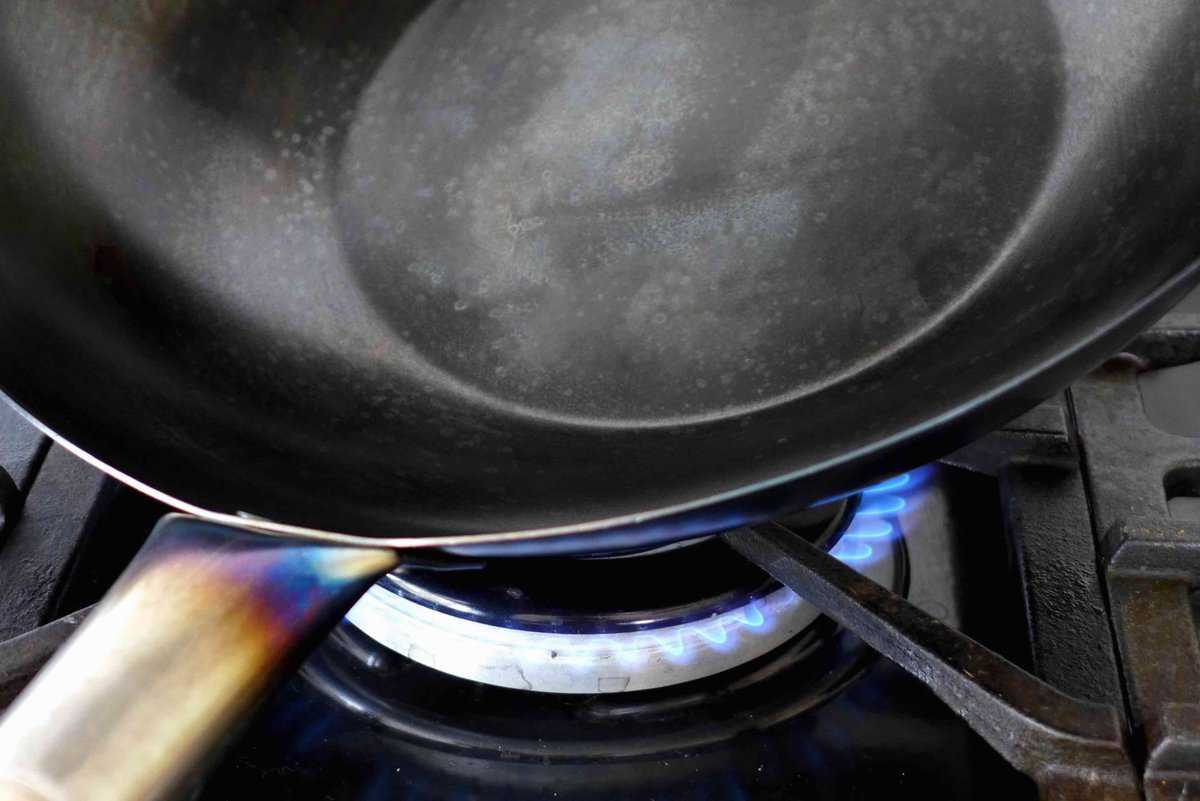
Repeat the procedure until you’ve burned off all the oil coating and no more smoke appears. The wok should now have gained a greyish black finish.
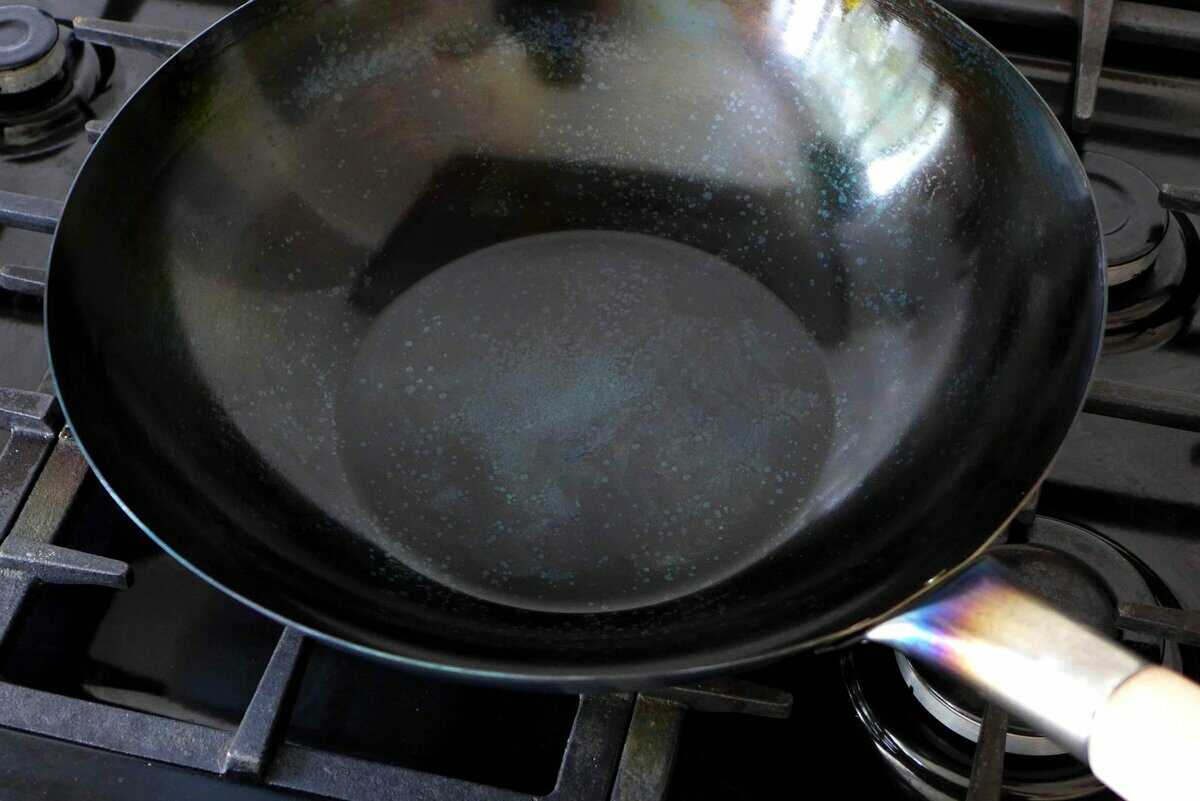
Leave to cool then rub another layer of oil and repeat the procedure. After that, your wok is properly seasoned and ready to be used! See the comparison images below how it has transformed!
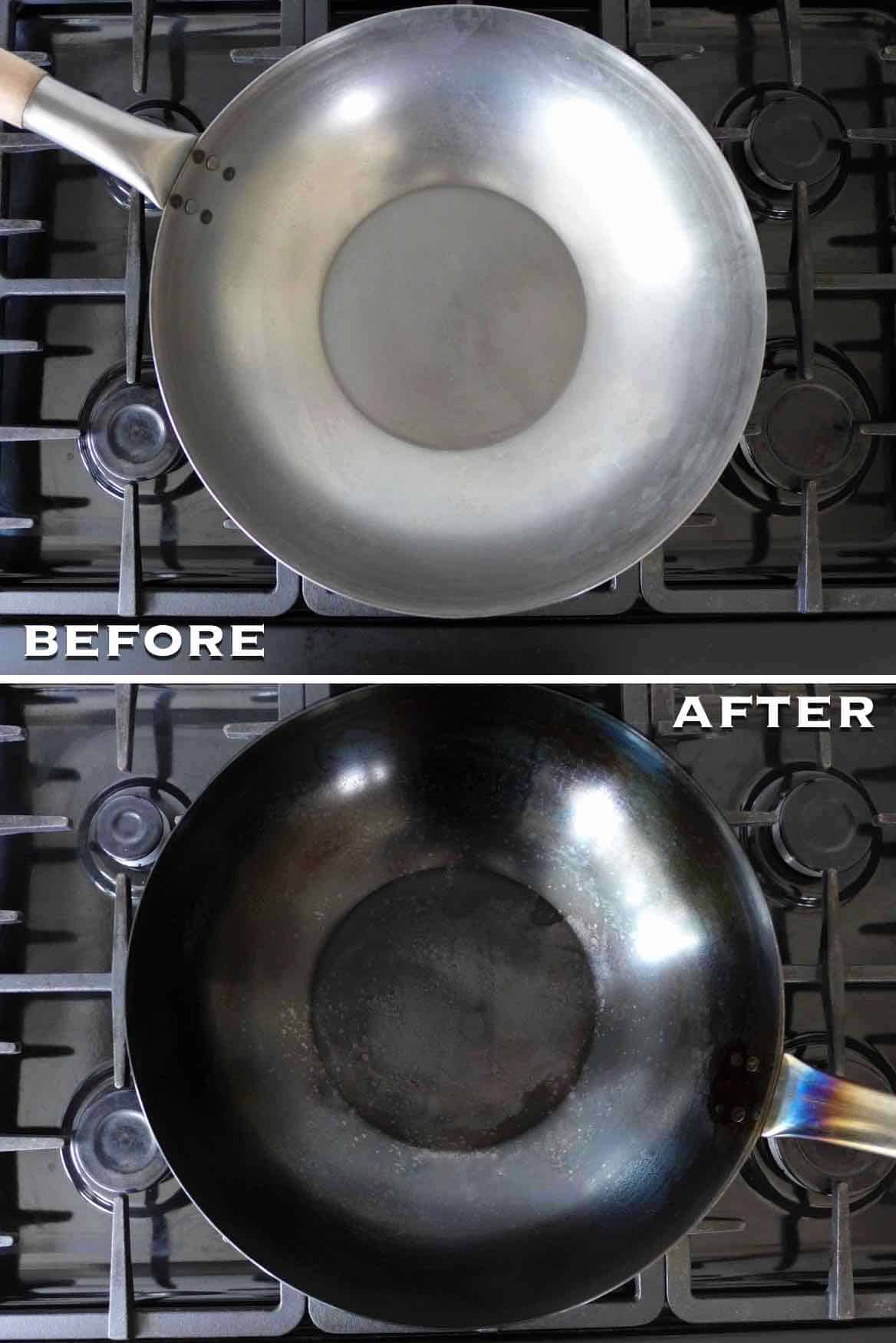
Maintain
It’s easy to maintain a carbon steel wok in its good condition as long as you follow a few simple steps every time you clean it.
Clean as soon as possible
Right after cooking, rinse it under warm running water and use a sponge or a bamboo/plastic brush to remove any food and residues.
If there is burned food hard to remove, fill it with hot water and leave to soak for a short while. Then wash it using the same method.
Use detergent if you want
Unlike some suggestions you may find elsewhere, it’s perfectly fine to apply a little dish detergent as it helps to remove any grease effectively. But make sure you always rinse it properly afterwards.
Dry it over a burner
The crucial part of wok maintenance is to dry it completely each time after washing. Use a cloth to wipe off any water inside and out. Then place it over a burner. Turn on the heat to dry it completely. This is the best way to remove any remaining moisture which may cause rusting.
Coat with oil when necessary
If you use your wok regularly, at least a couple of times a week, the above procedure would be enough. However, if you leave it unused for quite a while (especially in a humid environment), I suggest you coat it, inside and out, with a very thin layer of oil.
Don’t cook acidic food for long
The acid in food could remove the patina built upon the wok’s surface. If the ingredients are highly acidic, make sure they’re not cooked in the wok for a lengthy period.
For example, it’s fine to quickly stir-fry chopped tomatoes with eggs, but don’t make a tomato sauce which requires a longer time. If the recipe calls for vinegar, add it at the very end of the cooking process.
Don’t leave food in it
Transfer the food to a serving plate/bowl as soon as it is cooked. Do not use the wok as a storage container.
Other tips
- Do not clean your carbon steel wok in a dishwasher (You may do so with stainless steel woks).
- If you’re making two or more dishes consecutively using the same wok, it’s recommended to give it a quick rinse and wipe dry in between each cooking session.
- A frequently used wok won’t look as even-coloured as your other cookware. You may see different colours or stain-like spots here and there. This is because patina develops and changes over time. There is nothing to worry about or fix.
Restore
If you accidentally forget to dry the wok properly, the moisture trapped inside the metal will cause rusting. Don’t panic or throw it away! Unlike damaged non-stick cookware, carbon steel woks can be easily restored to an as-new condition by re-seasoning using the same technique.
Like how you remove the protective layer on a new wok, scrub all the rusted areas with a scourer. Burn the wok empty to remove all the moisture. Then burn it twice again with a thin layer of oil on.
You can re-season as often as you need to do so. It won’t damage your hardy carbon steel wok.
Stir-fry
Making stir-fried dishes is the most common use of a wok. With a little oil and a few condiments, almost all types of ingredients (meat, fish, seafood, vegetables, rice, noodles, etc.) can be stir-fried in this cookware.
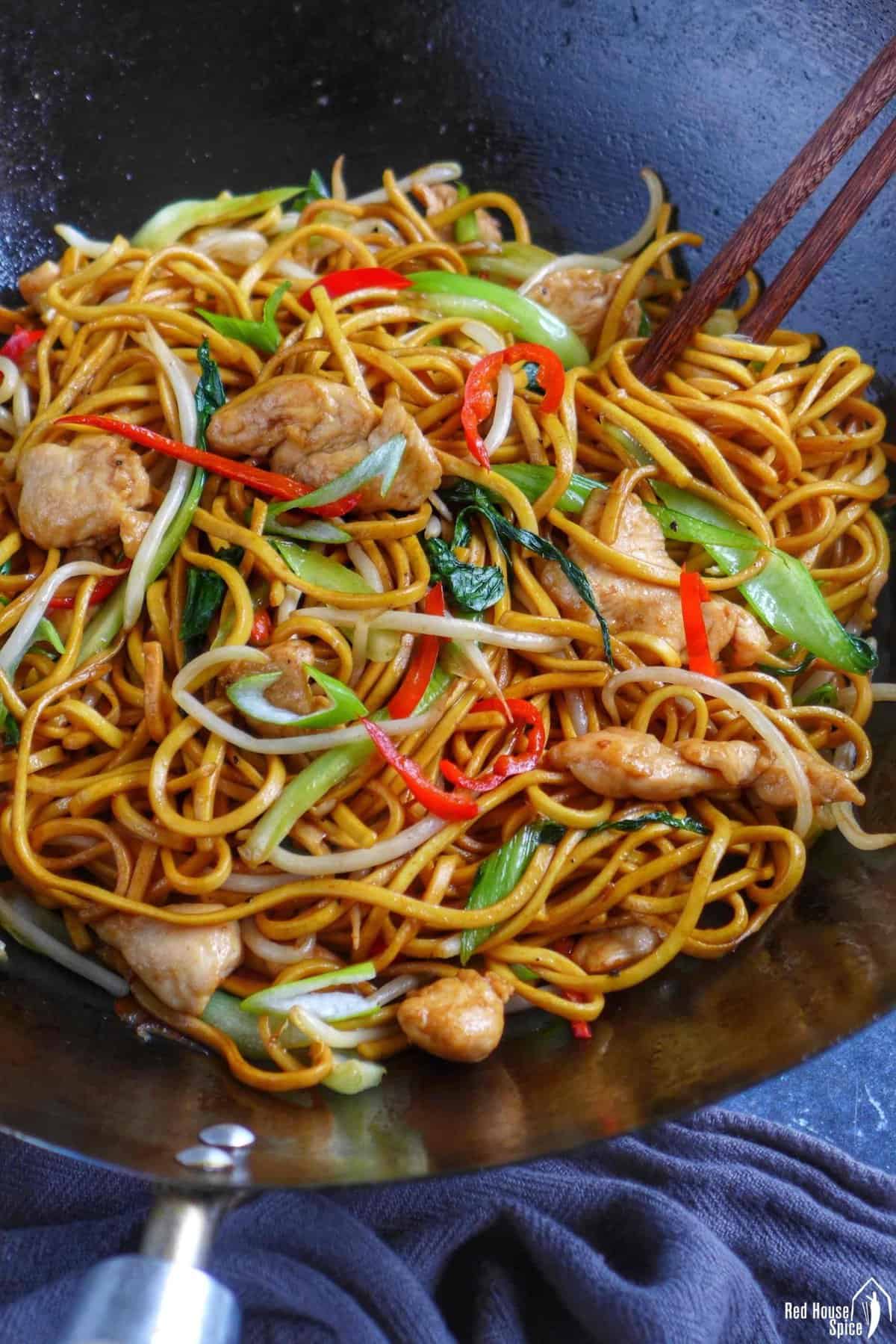
Like what you use to season the wok, you’d need to use high heating oils for stir-frying. Also, chop the ingredients into small, similar-sized pieces (slices, strips, cubes, slivers, etc.). This ensures that they are cooked through quickly and evenly.
How to prevent sticking
A well-seasoned wok doesn’t guarantee that the food never sticks to it, especially when cooking meat, eggs, etc. The key to preventing sticking is to make sure the wok is scalding, but the oil isn’t at a high temperature when you put in the ingredients.
This concept is known as Re Guo Liang You/热锅凉油 in Chinese, meaning “hot wok cold oil”. It helps you to achieve a non-stick effect without burning your food. You may apply either of the following techniques:
- The professional chefs’ way: Add a ladleful of oil to the wok and swirl it around to cover most of the inner surface. When it starts to smoke, pour it all out into a heatproof bowl. Add new cold oil, with the quantity suggested in the recipe, and start cooking straightaway.
- The home cooks’ way: Heat the wok empty until you see smoke arise. Add oil then start cooking. If you’re unsure if the wok is hot enough, add a drop of water to test. If it immediately turns into small rolling balls then disappears, it has reached the optimal temperature.
If the above techniques don’t work, your wok probably needs to be re-seasoned. Follow the same instructions explained in the “seasoning section” above.
Here are some classic yet simple stir-fries to try:
Other usage
Steaming
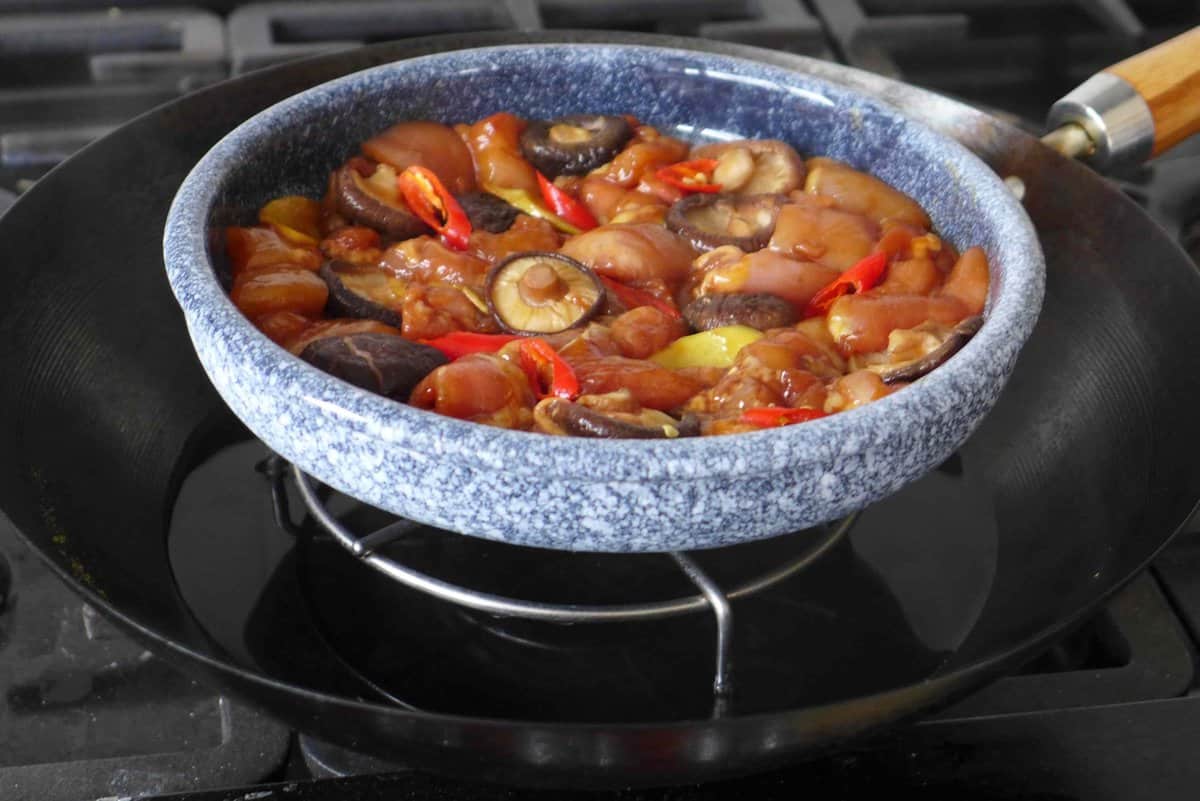
To me, steaming is the second most used method with a wok. You can either use it to hold bamboo steamer baskets to cook Steamed Pork Bao Buns, Steamed Dumplings; or place a steamer rack in the middle to prop up plates for Steamed Fish, Steamed Chicken with Mushroom, etc.
Pan-frying
This method uses a little oil to cook or brown food without moving the ingredients too often during the process. If your wok has a flat bottom, you can use it to pan-fry Scallions Pancakes or Dumplings.
Shallow-frying
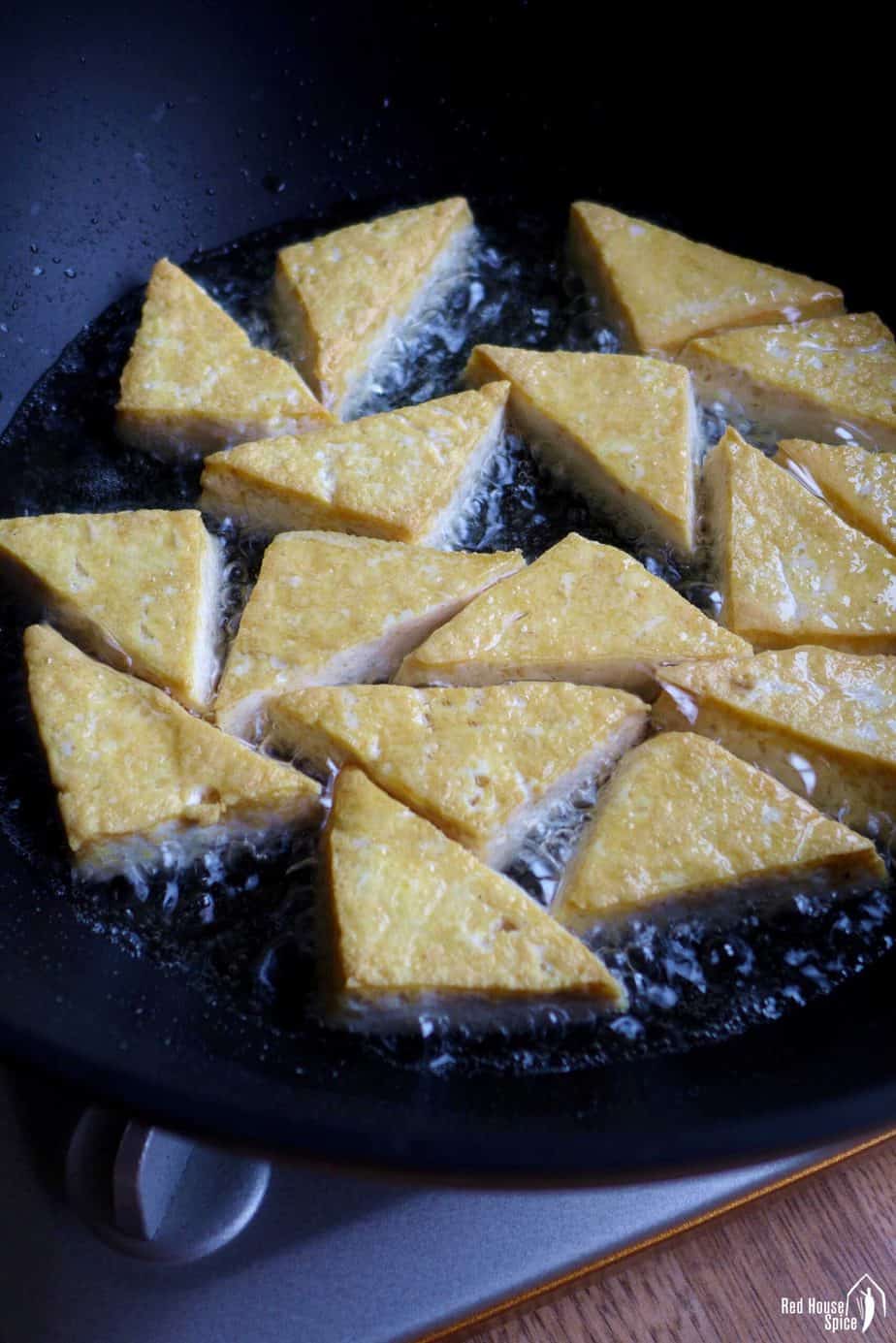
Unlike deep-frying in which ingredients are fully immensely in oil, shallow frying refers to frying food in oil that only covers about ¼ to ⅓ of its height. For example, you can use your wok to shallow fry Sichuan Home-style Tofu.
Deep-frying
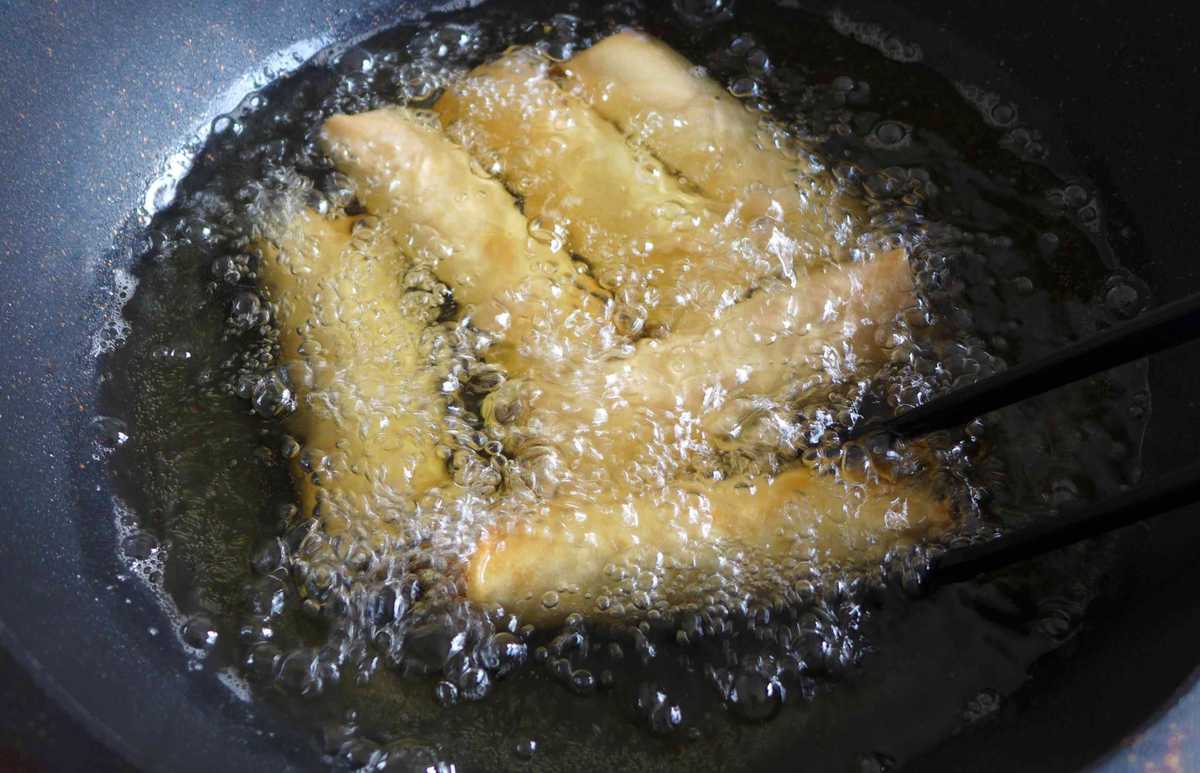
A wok is ideal for deep-frying. Compared to using cookware with a straight side, wok holds less oil for deep-frying the same amount of food thanks to its curved bowl shape. Use it to try my recipes for Spring Rolls, You Tiao (Chinese doughnut sticks), Salt and Pepper Shrimp, etc,
Braising
Classic dishes you can braise in the wok include Mapo Tofu, Sichuan Boiled Fish, Ginger Chicken, etc.
Smoking
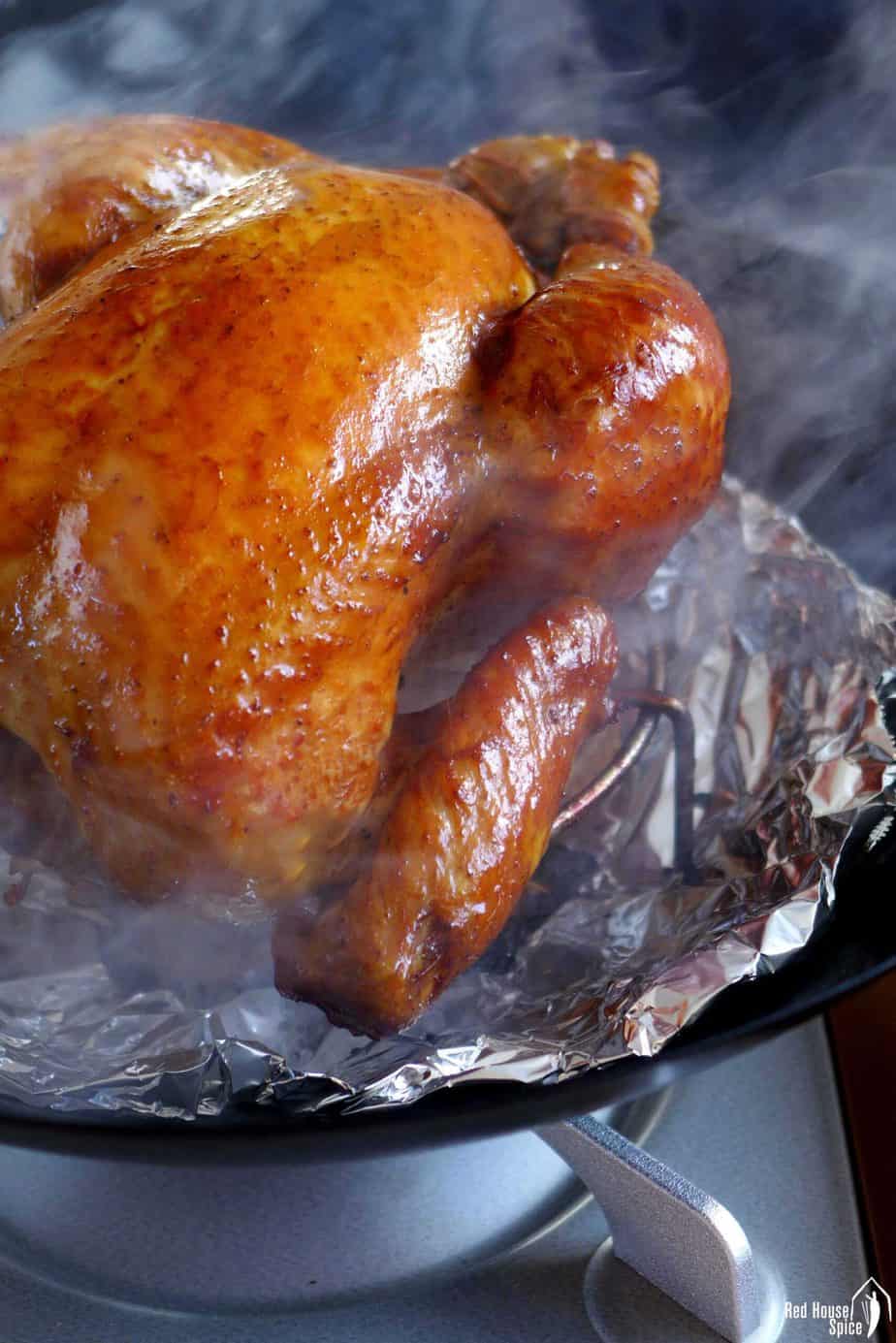
Do you know that a wok can be used as a smoker? The set-up is simple: lay a piece of aluminium foil at the centre of the wok. Add sugar, tea leaves and raw rice on top. Heat up until smoke appears. Put in a wire rack to prop up the food you’d like to smoke. Cover with a lid then leave to smoke for a few minutes. Check out my recipe for Smoked Chicken to learn more.
Blanching
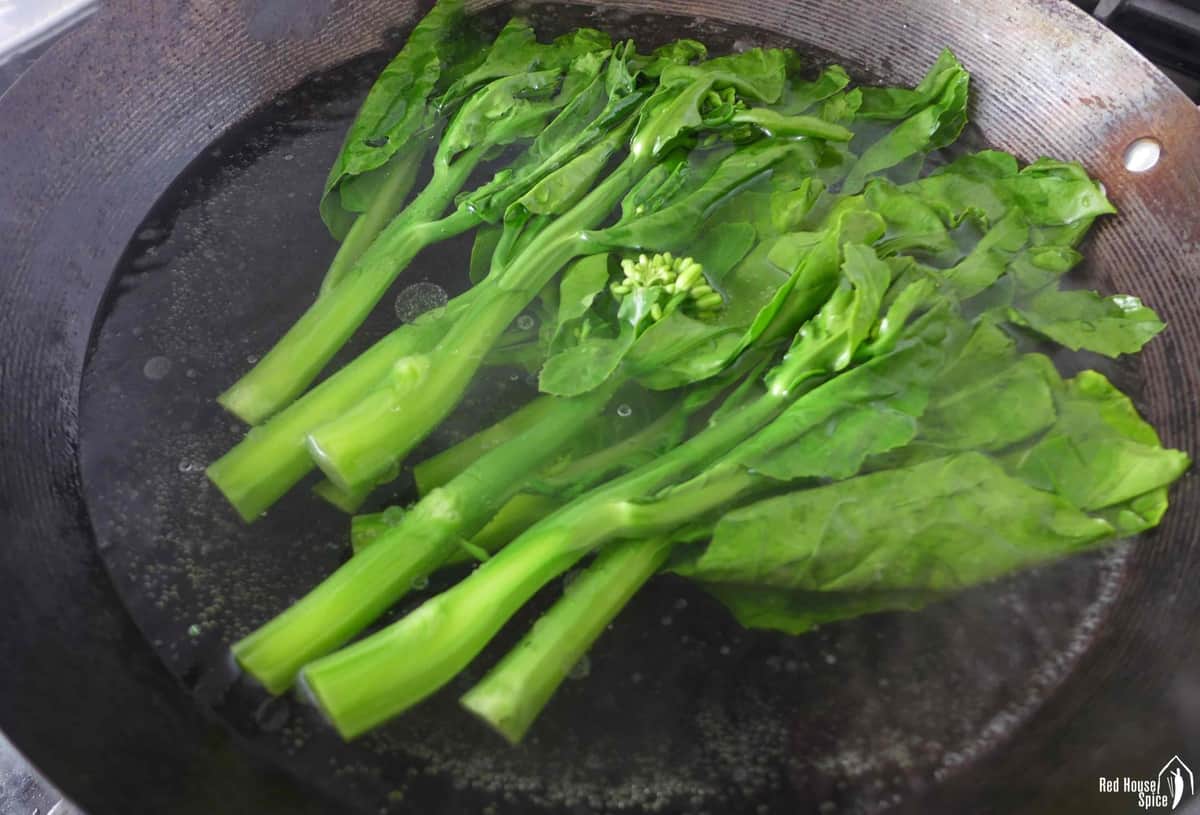
A quick blanching is often required in Chinese cuisine for removing the impurity of meat before the real cooking starts. Beef Stew with Potatoes is a good example. Also, vegetables can be blanched in a wok and then served with an umami-rich sauce. Try Bok Choy with Shiitake and Chinese Broccoli with Oyster Sauce.
Simmering
Similar to blanching, you can use the wok to replace a saucepan/pot to simmer food. For example, make Hot and Sour Soup, Egg Drop Soup, etc.
FAQs
A: You can make delicious stir-fries without tossing the ingredients in the air and having flames around the wok. For home cooking, it’s perfectly fine to stir and flip the ingredients with a spatula. The key is to move them constantly to cook and season evenly.
A: What makes it challenging is that you can’t regulate the heat output of an electric burner as efficiently as that of a gas burner. When a recipe requires you to turn down the heat immediately, you’ll need to lift the wok off the burner periodically to avoid burning/overheating before the burner reduces its heat to the desired temperature.
A: These are two possibilities: 1) Your burner isn’t powerful enough so the temperature isn’t as high as required. If this is the case, try cooking a smaller portion of ingredients at once; 2) You misjudged the timing so you’ve overcooked the dish. Try reducing the time.
A: It’s not recommended to overcrowd the wok. Adding a large volume of ingredients at once would cause the temperature to plummet. You’ll end up steaming the food instead of searing it. If you’re to make a big portion, cook different ingredients separately then combine at the end.
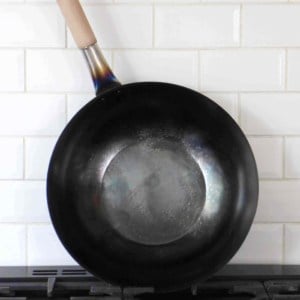
Wok: How To Season and Maintain
N.B.
EQUIPMENT
- Carbon steel wok (unseasoned)
- Stainless steel scourer
MATERIALS
- Washing-up liquid
- High heating oil (e.g. canola, sunflower, rapeseed, corn, peanut, soybean, vegetable oil, etc.)
- Kitchen paper
Method
Remove the protective layer
- Wet a stainless steel scourer in warm water mixed with a little washing up liquid. Then vigorously rub the surface of the wok inside and out to remove its protective coating. Make sure you don’t miss any area.
- Rinse thoroughly then wipe dry with a kitchen towel.
Burn it empty
- Place the wok over a burner with high heat. Burn it thoroughly. You’ll notice the colour changing during this process, from silver-grey to golden, brown, a metallic rainbow shine, then finally settle down to a bluey grey colour.
- To make sure it's entirely burnt, hold the handle and move it in different directions so that each part has a chance to be in direct contact with the heat.
- Once all is done, let it sit for 5 minutes or so until it’s cool enough to handle.
Burn it with a little oil
- Pour a little oil into the wok. Use a piece of kitchen paper to rub the oil around the inner surface leaving just a very thin layer.
- Burn it again over high heat. Focus on one area at a time. You’ll see smoke rise from the heated part and the colour darkens. When there is no more smoke appearing, move on to another area.
- Once you’ve burned off all the oil coating and no more smoke appears, the wok should have gained a greyish black finish.
- Leave to cool then rub another layer of oil and repeat the procedure. Then your wok is properly seasoned and ready to be used.
Clean it after cooking
- Right after cooking, rinse it under warm running water and use a sponge or a brush to remove any food and residues (use a little detergent to remove grease if necessary). If there is burned food hard to remove, fill it with hot water and leave to soak for a short while. Then wash it using the same method.
- Use a cloth to wipe off any water inside and out. Then place it over a burner. Turn on the heat to dry it completely (don't skip this procedure).
- If you don't use the wok regularly, or your kitchen is humid, I suggest you coat it inside and out with a very thin layer of oil once it has cooled down.







Could you please suggest a few places that sell a good wok with the larger flat bottom? I love cooking Asian dishes and definitely would love a much better wok.
Hi Rebecca! My woks are from a UK retailer and Amazon (I can not share commercial external links here). Since carbon steel woks are made of basic material and there is no high-tech involved, I don’t think you need to worry too much about the brand. The most important thing is to season, use and maintain them properly.
Hi,
“The home cooks’ way: Heat the wok empty until you see smoke arise. Add oil then start cooking.”
Should I wait for the oil to be hot to add food? Or just add the food right away in the oil?
Thank you.
As long as the wok is very hot when you add the oil, you can start frying the food right away!
I’ve been using a wok for years, but I’ve learned so much more with your Wok Guide. Thank you so much for this information!
You’re welcome Lisa. So happy to know you find my guide helpful!
Although I have tried all the scrumptious authentic recipes, the ones I have were simple AMAZING. Thanks for sharing must haves ingredients for cooking different recipes. Keep em coming, IM LOVING and LEARNING every minute.
Really helpful
Thanks
You wrote this blog very well. Very knowledgeable. Thanks for sharing this